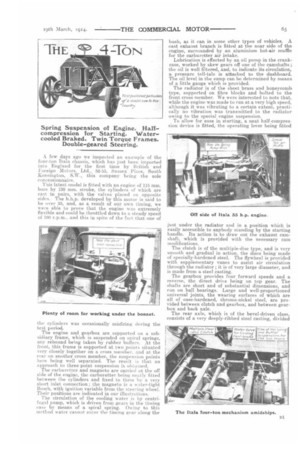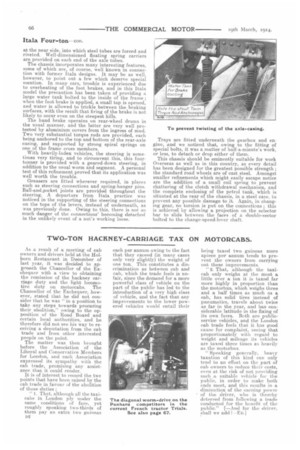THE "TaN
Page 15

Page 16

If you've noticed an error in this article please click here to report it so we can fix it.
A few days ago we inspected an example of the four-ton Itala chassis, which has just been imported into England for the first time by British and Foreign Motors, Ltd., 52-53, Sussex Place, South Kensington, S.W., this company being the sole eoncessionnaire.
This latest model is fitted with an engine of 115 mm. bore by 130 mm. -stroke, the cylinders of which are east in pairs, with the valves placed on opposite sides. The b.h.p. developed by this motor is said to be over 35, and, as a result of our own timing, we were able to prove that the engine was extremely flexible and could be throttled down to a steady speed of 160 r.p.m., and this in spite of the fact, that one of the cylinders was occasionally misfiring during the test period. The engine and gearbox are supported on a subsidiary frame, which is suspended on spiral springs, any rebound being taken by rubber buffers. At the front, this frame is supported at two points situated very closely together on a cross member. and at the rear on another cross member, the suspension points here being well separated. The result is that an approach to three-point suspension is obtained. The carburettor and magneto are carried at the off side of the, engine, the carburetter being neatly fitted between the cylinders and fixed to them by a very short inlet connection ; the magneto is a water-tight Bosch, with ignition variable from the steering wheel. Their positions are indicated in our illustrations.
The circulation of the cooling water is by centrifugal pump, which is driven from gears in the timing case by means of a spiral spring. Owing to this method water cannot enter the timing gear along the bush, as it can in some other types of vehicles. A cast exhaust branch is fitted at the near side of the engine, surrounded by an aluminium hot-air muffle for the carburetter air intake.
Lubrication is effected by an oil pump in the crankcase, worked by skew gears off one of the camshafts ; the oil is well filtered, and, to indicate its circulation, a pressure tell-talc is attached to the dashboard. The oil level in the sump can be determined by means of a little gauge which is provided. The radiator is of the sheet brass and honeycomb type, supported on fibre blocks and bolted to the front cross member. We were interested to note that, while the engine was made to run at a very high speed, although it was vibrating to a certain extent, practically no vibration was transmitted to the radiator owing to the special engine suspension. To allow for ease in starting, a neat half-compression device is fitted, the operating lever being fitted just under the radiator and in a position which is easily accessible to anybody standing by the starting handle. Its action is to draw out the exhaust camshaft, which is provided with the necessary cam modifications.
The clutch is of the multiple-disc type, and is very smooth and gradual in action, the discs being made of specially-hardened steel. The flywheel is provided with supplementary vanes to assist air circulation through the radiator ; it is of very large diameter, and is made from a steel casting. The gearbox provides four forward speeds and a. reverse, the direct drive being on top gear. The shafts are short and of substantial dimensions, and run on ball bearings. Large and well-proportioned universal joints, the wearing surfaces of which are all of case-hardened, chrome-nickel steel, are provided between clutch and gearbox, and between gearbox and back axle.
The rear axle, which is of the bevel-driven class, consists of a very deeply-ribbed steel casting, divided at the near side, into which steel tubes are forced and riveted. Well-dimensioned floating spring carriers are provided on each end of the axle tubes.
The chassis incorporates many interesting features, some of which are, of course, well known in connection with former Itala designs. It may be as well, however, to point out a few which deserve special mention. In many cars, trouble is experienced due to overheating of the foot brakes, and in this Itala model the precaution has been taken of providing a large water tank bolted to the inside of the frame ; when the foot brake is applied, a small tap is opened, and water is allowed to trickle between the braking surfaces, with the result that firing of the brake is not likely to occur even on the steepest hills. The hand brake operates on rear-wheel drums in the usual manner, and the latter are very well protected by aluminium covers from the ingress of mud. Two very substantial torque rods are provided, each being anchored to the top and bottom of the rear-axle easing, and supported by strong spiral springs on one of the frame cross members.
With heavily-laden vehicles, the steering is sometimes very tiring, and to circumvent this, this fourtonner is provided with a geared-down steering, in addition to the usual worm and segment. A personal test of this refinement proved that its application was well worth the trouble.
Greasers are fitted wherever required, in places such as steering connections and spring-hanger pins. Ball-and,socket joints are provided throughout the steering. A departure from Itala practice was noticed in the supporting of the steering connections on the tops of the levers, instead of underneath, as was previously done. Owing to this, there is not so much danger of the connections' becoming detached in the unlikely event of a nut's working loose. Trays are fitted underneath the gearbox and engine, and we noticed that, owing to the fitting of special bolts, it was a matter of half-a-minute's work, or less, to detach or drop either of them.
This chassis should be eminently suitable for work Overseas as well as in this country, as every detail has been designed for the greatest possible strength ; the standard road wheels are of cast steel. Amongst smaller refinements which might easily escape notice are the addition of a small coil spring to prevent chattering of the clutch withdrawal mechanism, and the complete enclosing of the petrol tank, which is situated at the rear of the chassis, in a steel case, to prevent any possible damage to it. Again, in changing gear, no torsion is put on the connections ; this is achieved by allowing a projection on the selector bar to slide between the faces of a double-sector bolted to the change-speed-lever shaft.


























